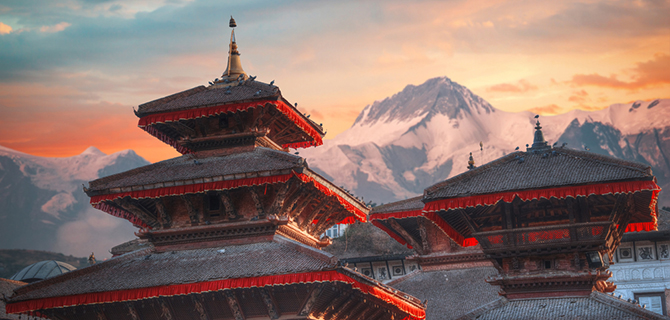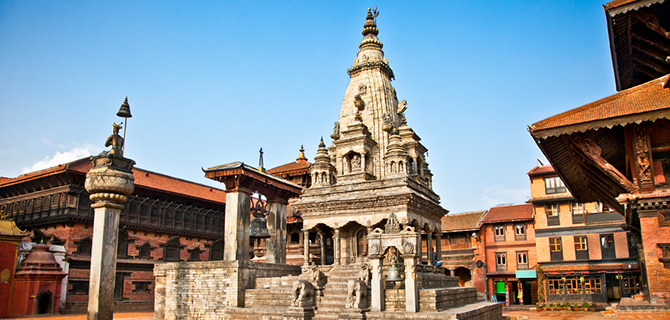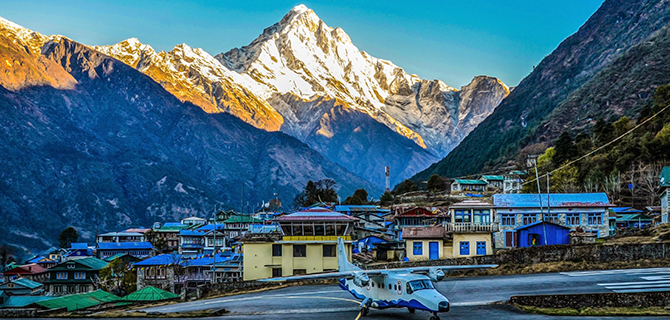The Details
Day 1
Arrive in Kathmandu and Meet the Team
Welcome to Kathmandu, the capital of Nepal! Your guide will meet you at Tribhuvan International Airport and transfer you to your hotel in the city center.

Nepal boasts eight of the world's tallest mountains and the world's oldest Hindu and Buddhist sites. The country is filled with enchanting medieval palaces, pagodas, temples, statues and stupas; as well as unparalleled adventure options. In the tropical jungles, the regal Bengal tiger prowls; higher up the legend of the Yeti lives on. Although modernization has set in, the quintessence of ancient Nepal remains amongst its people and its landscapes.
Day 2
Kathmandu & Bhaktapur Tour
The capital of Nepal is also the biggest metropolitan center in the Himalayas. Kathmandu is filled with Buddhist and Hindu temples, sweet-smelling gardens, and charming squares, including the World Heritage Site Durbar Square. Nearby Bhaktapur is a beautifully-preserved city from medieval times. However, like much of Nepal, both were devastated by the earthquake of 2015. Join your guide on a tour of both sites to discover more about the history and culture of the region and learn about its efforts to rebuild in the wake of disaster. End your day with a restful evening before you journey to the Himalayas and begin hiking tomorrow.

Day 3
Lukla to Phakding
The challenge begins. The trek is about eighty miles total, and we will be covering an average of five miles a day. We will fly to Lukla, gateway to the Solu-Khumbu region of Nepal. This district, well-known as the Everest region, is the native land of the Sherpas, the renowned climbers and mountaineers. The area possesses a mountainous landscape of unique beauty, and within its vicinity lie some of the highest peaks in the world.

Our trek begins here in Lukla, and we will start gaining elevation right away. We will stop in Phakding and stay overnight in a teahouse to rest.
Teahouse in Phakding : Elevation: 2,880 m/ 9,450 feet : Trekking time: 4 hours
Day 4
Phakding to Namche
This morning we will continue gaining elevation and hike from Phakding to Namche.

The Solu-Khumbu region is fascinating and justifiably famous, not only for its proximity to the world's highest mountain, but also for its Sherpa villages and Buddhist monasteries. This slow paced exploration allows us to enjoy the grandeur of Khumbu peaks and time to interact with Sherpas. Their clothing, speech, and sect of Buddhism are all inspired by nearby Tibet. Here in Namche, a weekly Saturday market at the Bazaar presents opportunities to socialize and trade among people from neighbouring villages.
Teahouse in Namche : Elevation: 3,440 m/ 11,285 ft : Trekking time: 5 hours
Day 5
Rest day
Today will be a day of rest, and we will embark on a short hike in the area to acclimatize. At such a high elevation, it is important to move slowly in order to give the body a chance to adjust to the altitude. Taking breaks and hiking only a few hours each day allows our bodies to adapt and greatly reduces the chance of altitude sickness while increasing chances for success. We may also visit the Sagarmatha National Park Museum, where we can learn more about the geography and history of the region.

Teahouse in Namche : Elevation: 3,440 m/ 11,285 ft
Day 6
Namche to Deboche
We will hike to Deboche, and retire at a teahouse for dinner and to sleep. The tea houses are usually small basic lodges offering accommodation and food for travellers, and allow us to travel with minimal equipment. They are also a meeting point for trekkers from various parts of the world. This system keeps the trek economical and requires little technical experience.

Teahouse in Deboche : Elevation: 3,870 m/ 12,700 ft : Trekking time: 5 hours
Day 7
Deboche to Dingboche
We continue our trek on to Dingboche, all the while witnessing the unbelievable abundance of wildlife endemic to the Everest region. Nepal’s national bird, the multi-colored Himalayan monal, dwells in the vicinity. Golden eagles dominate the skies. Flocks of snow pigeon, blood and crimson horned pheasants, Goshawks and Eurasian kestrels are all found here. Opportunities to spot the endangered Himalayan musk deer, commonly known as kasturi mriga, are highly likely in this area. Himalayan tahr, a relative of the mountain goat, also reside in this high altitude land.

Teahouse in Dingboche : Elevation: 4,260 m/ 14,000 ft : Trekking time: 5 hours
Day 8
Rest Day
Today is another acclimatization day. We may take a hike to nearby Chukung Valley, which was originally used as a yak pasture and is surrounded by picturesque glaciers.

Teahouse in Dingboche : Elevation: 4,260 m/ 14,000 ft : Optional trekking time: 3 hours
Day 9
Dingboche to Lobuche
This is the last full day of trekking before we reach our final destination. Lobuche is a rustic settlement that is flurry of Sherpas, porters, and travelers on their way to and from Everest base camp, which is just a few short kilometers away. The trekking is hard, but you will be rewarded with boundless beauty and kindness from the locals and from your new friends. We rest in Lobuche for the night before making a final push for a magnificent view of Mount Everest in the morning.

Teahouse in Lobuche : Elevation: 4,930 m/ 16,175 ft : Trekking time: 4 hours
Day 10
Kala Patthar
We will wake up before the sun and trek to Kala Patthar, a promontory of black rock that is the goal of trekkers in the Everest region. Standing at an altitude of 5623m / 18,450 ft, this spot provides 360 degrees of up close, breathtaking vistas of Mount Everest and other nearby mountains. This is the highest point of our trek, both literally and figuratively. After soaking in the views, we return to Lobuche for an afternoon of recuperation and celebration.

Teahouse in Lobuche : Elevation: 4,930 m/ 16,175 ft : Trekking time: 7 hours
Day 11
Lobuche to Pangboche
We begin our return trek. Since we are losing altitude on the way down, it will become easier to breathe with each step, and we will be able to hike much faster. The village of Pangboche is the oldest settlement of the Sherpas in the region and one of the highest villages in the world. The monastery here once held a skull and a hand believed to be the remnants of the elusive Yeti.

Teahouse in Pangboche : Elevation: 3,985 m/ 13,075 ft : Trekking time: 5 hours
Day 12
Pangboche to Khumjung
We continue our trek down. On the way to our shelter for the night, we stop at Phortse, a small farming village. This community is off the usual path taken by Everest hikers and therefore is a more traditional example of a Sherpa village high in the Himalayas.

Teahouse in Khumjung : Elevation: 3,790 m/ 12,430 ft : Trekking time: 5 hours
Day 13
Khumjung to Monjo
As we lose elevation, we will notice the transition of vegetation from the alpine to subalpine biomes. Blue pine and juniper shrubs thrive above 4000 m, whereas at lower elevations we will find chir pine, hemlock, silver fir and Juniper trees. We stop through the familiar village of Namche on our way to Monjo, which is at an elevation very close to our end point.

Teahouse in Monjo : Elevation: 2,835 m/ 9,300 feet : Trekking time: 4 hours
Day 14
Monjo to Lukla
Our trek ends with our arrival back at Lukla. After facing twelve days of challenging terrain in the highest mountains in the world, you are able to rest knowing you have hiked all the way to Everest base camp and back, a true dream come true!
Hotel in Lukla : Elevation: 2,860 m/ 9,380 ft : Trekking time: 4 hours
Day 15
Return to Kathmandu
We say goodbye to the Everest region and fly back to Kathmandu from Lukla. You will have the whole day at your leisure to explore the city more or relax at the hotel. We finish the tour with a final dinner, where we can relive our adventure and celebrate our victory one last time before departure.

Day 16
Departure
Your guides will transfer you back to the airport for your flight home. You also have the option to explore Nepal more with a customized extension in the region.


